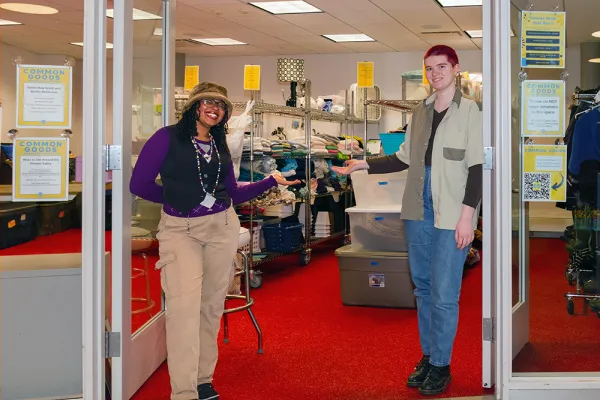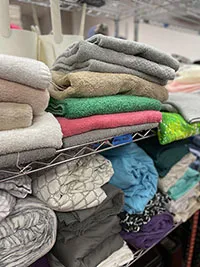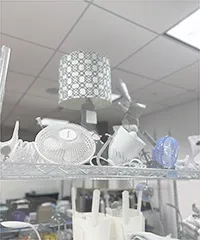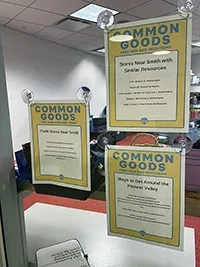Desk Lamps to Dental Floss
Campus Life
Founded and run by students, Common Goods has something for everyone

Published March 23, 2023
When Carrie Weil ’22 and Emma Ryan ’22 founded the Common Goods Resource Center in the fall of 2021, they envisioned it as a hub run by students, for students that offered a range of useful items like laundry detergent, shampoo, and bed linens at no cost.
Now, nearly two years later, Weil and Ryan’s original vision has come to life, with the center fully operational and more and more students finding their way to it every day. In the fall of 2022, for example, the center, which is located on the lower level of the Julia McWilliams Child ’34 Campus Center, had about 300 registered users. By the end of the semester, that number had nearly doubled. “The more students hear about Common Goods, the more they use it,” said Tamra Bates, director of student engagement who also serves as the center’s staff administrator, hiring students and helping them manage the center and maintain its inventory.

Though Bates is the administrator for the resource center, she says students are the face of Common Goods. “I impress upon the students that they should do whatever feels good and makes sense for students,” Bates said. “They take ownership of that, so it really is a student-run space.”
Since the center’s launch, international students, in particular, have been quick to utilize Common Goods, after learning about it in their Smith orientation program. Most sought-after items for international students? Hands down, winter coats, said Bates. For now, outerwear (fall and spring jackets, winter coats, boots) is the only category of clothing that Common Goods can offer students. “Eventually, our hope is to expand to offer more clothing, so it works almost like a thrift store,” Bates said.
Toiletries and laundry supplies—always hot commodities—are purchased by Smith staff. But all other items, such as sheets, blankets, winter coats, closet organizers, and coffeemakers, are donated. Many items come through SmithCycle, a program that collects things from students moving off campus. Other donations come from faculty and staff. Bates takes donated linens and blankets home to wash before putting them in stock.

Mackenzie Martin ’26 and Naia Owens ’26 both work at Common Goods and are also customers. Owens was a devoted Common Goods shopper even before she started working there in January. “I would drag my friend with me and go looking for cool wall decorations or coats,” Owen said. “I found one of my favorite hats there, and I was recently able to get all of the class supplies I needed.” Martin thinks one of the best things about Common Goods is that it offers more than just the bare necessities. “We have a lot of cool stuff,” Martin said. “Just because you may not absolutely need something to survive doesn’t mean Common Goods isn’t for you. And just because you can’t afford something doesn’t mean you don’t deserve to have it. We carry the obvious things, like menstrual supplies, but you can also get a kettle to have friends over for tea.”
Owens, who also runs Common Goods’ Instagram, agrees that the center is a welcoming place for all students. “I have often found that the experience of visiting resource centers can either make me feel guilty for bringing home things other people can use or like I’m being put on blast for needing things and not being able to afford—or not wanting to pay for necessities I believe should be a right. I’ve never felt that way about Common Goods, as a customer or as an employee. I love watching people light up realizing that instead of having to wait for their fairy lights from Amazon or do without a binder or toiletries, they can usually get them here right away.”

Martin loves finding treasures in the donations—and watching students discover them, too. “Because we operate on the donation model, we have a lot of really funky one-off items, and helping people who have been looking for just that thing, find it—and to see their reaction—is, by far, my favorite part of the job,” Martin said.
It is not unusual for Common Goods to get some rather strange donations and requests. Martin remembers finding an “ultrasound bone healing system” among the donations, and Owens received a request for mosquito repellent in January. Bates cites a bowling set as being a bit unusual. The one item they usually have lots of—bed risers. “We have more bed risers than we can count,” Bates said.
The Common Goods’ wish list includes more space, a dedicated staff store manager, and a washer/dryer. But for now, Bates and student staff are focusing on increasing awareness of the resource center among students.
“When I first came to Smith, I was really intrigued by the idea of a campus community resource center,” says Martin. “I value intentional community, so creating a space where students can get their needs met, and not be dehumanized in the process, is something I am glad I am a part of.”
To donate items to the Common Goods Resource Center, contact the Office of Student Engagement or click here to make a monetary donation.
Naia Owens ’26 and Mackenzie Martin ’26 welcome students to Common Goods Resource Center. Photo: Jeff Baker